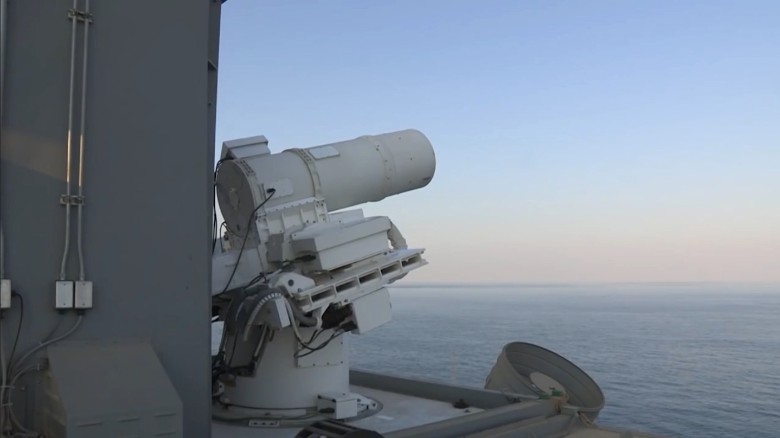
(CNN)In the sometimes hostile waters of the Persian Gulf looms the US Navy’s first — in fact, the world’s first — active laser weapon.
The LaWS, an acronym for Laser Weapons System, is not science fiction. It is not experimental. It is deployed on board the USS Ponce amphibious transport ship, ready to be fired at targets today and every day by Capt. Christopher Wells and his crew.
CNN was granted exclusive access to a live-fire test of the laser.
“It is more precise than a bullet,” Wells told CNN. “It’s not a niche weapon system like some other weapons that we have throughout the military where it’s only good against air contacts, or it’s only good against surface targets, or it’s only good against, you know, ground-based targets — in this case this is a very versatile weapon, it can be used against a variety of targets.”
LaWS begins with an advantage no other weapon ever invented comes even close to matching. It moves, by definition, at the speed of light. For comparison, that is 50,000 times the speed of an incoming ICBM.
“It is throwing massive amounts of photons at an incoming object,” said Lt. Cale Hughes, laser weapons system officer. “We don’t worry about wind, we don’t worry about range, we don’t worry about anything else. We’re able to engage the targets at the speed of light.”
CNN witnessed that speed and power firsthand.
For the test, the USS Ponce crew launched the target — a drone aircraft, a weapon in increasing use by Iran, North Korea, China, Russia and other adversaries.
Immediately, the weapons team zeroed in. “We don’t have to lead a target,” Hughes explained. “We’re doing that engagement at the speed of light so it really is a point and shoot — we see it, we focus on it, and we can negate that target.”
In an instant, the drone’s wing lit up, heated to a temperature of thousands of degrees, lethally damaging the aircraft and sending it hurtling down to the sea.
The strike comes silently and invisibly. “It operates in an invisible part of the electromagnetic spectrum so you don’t see the beam, it doesn’t make any sound, it’s completely silent and it’s incredibly effective at what it does,” said Hughes.
It is remarkably precise, which the Navy says could limit collateral damage in wartime.
“I can aim that at any particular spot on a target, and disable and destroy as necessary,” said Wells. “It reduces collateral damage — I no longer have to worry about rounds that may go beyond the target and potentially hurt or damage things that I don’t want to hurt or damage.”
All the $40 million system needs to operate is a supply of electricity, which is derived from its own small generator, and has a crew of three. No multi-million-dollar missile, no ammunition at all.
The cost per use? “It’s about a dollar a shot,” said Hughes.
Today, the laser is intended primarily to disable or destroy aircraft and small boats. “It’s designed with the intent of being able to counter airborne and surface-based threats,” said Hughes. “And it’s been able to prove itself over the last three years as being incredibly effective at that.”
However, the Navy is developing more powerful, second-generation systems which would bring more significant targets into its crosshairs: missiles.
Those missions remain classified. However, the commander and crew are very much aware of the potential capabilities. When we asked Wells if the current LaWS could shoot down a missile, he said simply “maybe” and smiled.

